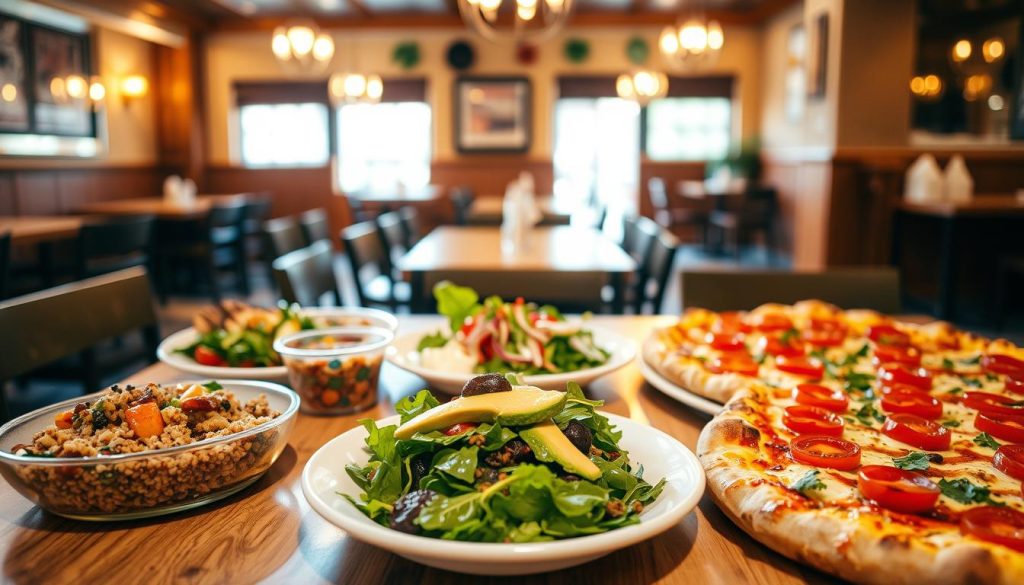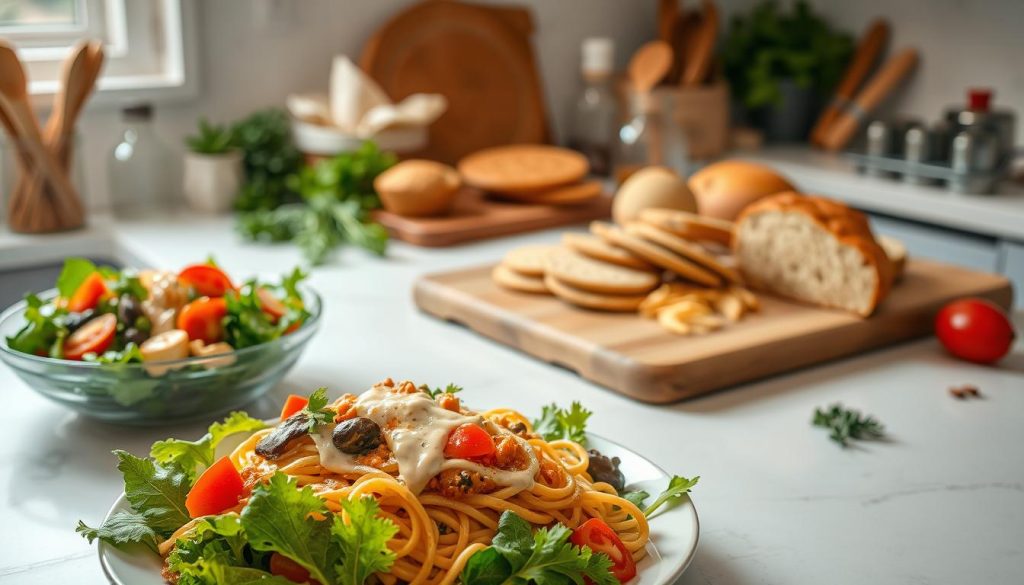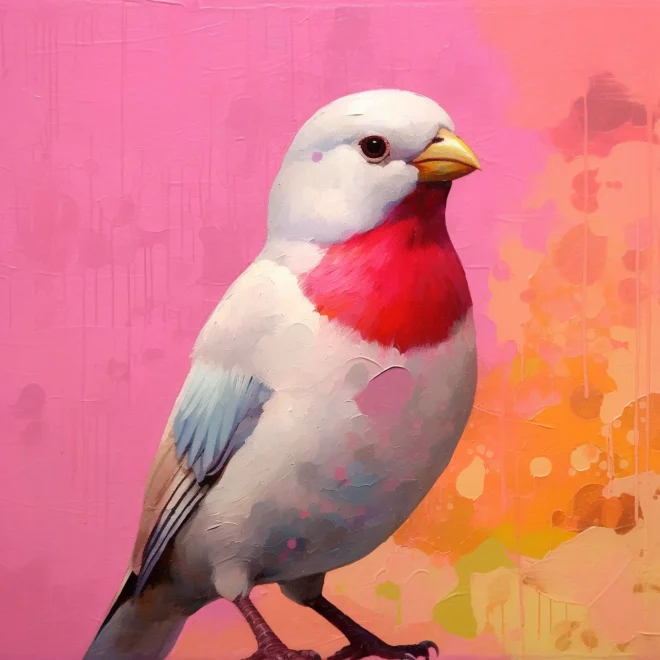Step into a world where gluten-free cooking turns simple meals into unforgettable experiences. From colorful salads to hearty main dishes, today’s gluten-free recipes are full of creativity. They show that you don’t have to give up flavor or fun, even with dietary restrictions.
Whether you’re just starting out or have been cooking gluten-free for a while, this guide is for you. It’s packed with practical tips and inspiring ideas to make every meal special. Let’s explore together and see how dietary needs can actually enhance our culinary adventures.
Key Takeaways
- Gluten-free cooking delivers diverse flavors and textures, breaking free from outdated stereotypes.
- Modern gluten-free recipes rival traditional dishes in taste and satisfaction.
- This guide provides actionable advice for every step of your culinary journey.
- Explore tested techniques to adapt favorite meals while maintaining nutrition and joy.
- Learn how to create meals that delight both gluten-free and non-gluten-free guests alike.
Understanding the Gluten-Free Lifestyle
Starting a gluten-free lifestyle is about clarity. Let’s clear up what it means. Whether you’re changing your diet or supporting someone, here’s what’s key.
What Does Going Gluten-Free Really Mean?
Gluten is a protein found in wheat, barley, and rye. A gluten-free diet means avoiding these. You’ll need to read labels and focus on gluten-free foods like fruits, veggies, and special grains.
Common Misconceptions About Gluten-Free Diets
- Myth 1: “Gluten-free = healthier.” Fact: It’s about safety, not health benefits.
- Myth 2: “Only people with celiac disease need it.” Fact: Sensitivities and personal choices count too.
- Myth 3: “It’s complicated.” Fact: beginner gluten-free recipes make it easier.
Who Benefits from Gluten-Free Eating?
Those with celiac disease or gluten sensitivity need this diet for health. Others might choose it for wellness or to avoid stomach issues. Even beginners can start with simple changes and easy meals.
Learning builds confidence. Whether it’s grocery shopping or trying beginner gluten-free recipes, knowing what to do makes the journey easier. Let’s make this transition welcoming, not scary.
The Science Behind Gluten-Free Cooking
Gluten is a protein in wheat and other grains that helps things stick together in baking. Without it, gluten-free cooking changes the texture and structure. But, science has found ways to fix this! By learning how ingredients work together, you can make great gluten-free dishes.
- Starches like potato or rice flour add lightness
- Xanthan gum mimics gluten’s elasticity
- Eggs or psyllium husk enhance moisture retention
“Gluten-free cooking isn’t about limits—it’s about creativity. Every ingredient has a purpose.” – Chef Marco Rivera, New York Times featured baker
Traditional baking uses gluten to hold air bubbles, making bread rise. In gluten-free recipes, we use starches and binders to get a similar effect. For instance, almond flour with tapioca starch makes things both dense and fluffy. This knowledge lets you try new things and succeed.
Whether you need to follow a gluten-free diet for health or personal choice, learning these tips can change your kitchen. Every choice of ingredient is a step towards making perfect gluten-free treats. Science and flavor come together, making your cooking journey more exciting.
Essential Gluten-Free Ingredients for Your Pantry
Starting a gluten-free pantry is key to cooking without gluten. With the right stuff, you can make tasty dishes easily. Let’s look at the main gluten-free items every kitchen should have.
Flours and Starches That Replace Wheat
Replace wheat with options like rice, almond, or coconut flours. Each offers a different feel:
- Rice flour: Light and crisp for pancakes or fried foods.
- Almond flour: Nutty flavor for cakes and crusts.
- Tapioca starch: Adds elasticity to baked goods.
Natural Gluten-Free Foods to Embrace
Nature has many gluten-free foods. Focus on these basics:
| Food Group | Examples | Best Uses |
|---|---|---|
| Grains | Quinoa, millet | Salads, side dishes |
| Legumes | Lentils, chickpeas | Soups, dips |
| Vegetables | Zucchini, sweet potatoes | Baked goods, roasted sides |
Reading Labels: Hidden Sources of Gluten
Always check labels for hidden gluten risks. Watch out for these words:
- “Modified food starch” (may contain wheat)
- “Hydrolyzed protein” (sometimes wheat-based)
- “Natural flavors” (rare but possible)
“Even trace amounts can impact those with celiac disease,” warns the Celiac Disease Foundation.
Knowing this helps turn your pantry into a creative space for gluten-free cooking. Try these ingredients to find new favorites. Your meals will be full of flavor and nutrition.
Mastering the Art of Gluten-Free Cooking
Turning regular recipes into gluten-free recipes needs creativity and skill. Here’s how to overcome challenges with easy gluten-free cooking tips:
Texture Challenges and Solutions
Removing gluten can lead to dryness or crumbling. Here are some fixes:
- For cakes and breads, add 1 tsp xanthan gum per cup of flour mix to improve structure.
- Use mashed bananas or applesauce in muffins to boost moisture.
- Increase liquid by 2-4 tablespoons when baking cookies or breads.
Flavor Enhancement Techniques
Use these methods to balance flavors:
- Boost umami with soy sauce or nutritional yeast.
- Add citrus zest or fresh herbs like rosemary for brightness.
- Experiment with smoked paprika or garlic powder for depth.
Adapting Your Favorite Recipes
| Original Ingredient | Gluten-Free Substitute |
|---|---|
| All-purpose flour | Cup-for-cup gluten-free blend |
| Wheat bread crumbs | Processed gluten-free oats |
| Regular pasta | Bean-based or rice noodles |
Begin by replacing 25% of wheat flour with a gluten-free blend in your first test batch. Taste as you go and adjust seasonings to highlight natural flavors. Remember: experimentation builds mastery!
Delicious Gluten-Free Breakfast Ideas to Start Your Day
Breakfast doesn’t have to be boring when you avoid gluten. Our gluten-free meals are packed with energy and creativity. They range from quick weekday meals to weekend treats, all delicious and easy to make.
- Chia pudding: Mix chia seeds with almond milk, sweeten with maple syrup, and top with mango or berries.
- Avocado smash: Mash ripe avocado on toasted Schar gluten-free bread with chili flakes and lime.
- Smoothie boost: Blend spinach, banana, protein powder, and almond milk for a 60-second breakfast.
“A fulfilling morning meal lays the foundation for mindful eating all day long.”
Weekend mornings? Dive into:
- Frittatas: Whisk eggs with dairy-free cheese, zucchini, and cherry tomatoes for a 20-minute bake.
- Pancakes: Use King Arthur’s gluten-free mix for stackable batter, topped with maple syrup and walnuts.
- Granola: Bake a batch of homemade mix using certified gluten-free oats and coconut oil.
These ideas show that mornings can be exciting without gluten. Every bite of these gluten-free recipes is a celebration of taste and health. You don’t have to pick between the two.
Satisfying Gluten-Free Meals for Lunch and Dinner
Making gluten-free meals easy doesn’t mean they can’t taste great. We focus on quick, tasty recipes. These dishes use ingredients like cauliflower rice and almond flour to make cooking simpler. They’re perfect for busy nights, dinner parties, and even picky eaters.

Quick Weeknight Dinner Solutions
Here are some tips to make your weeknights easier:
- One-pot wonders: Try chili or stir-fries with pre-chopped veggies and canned beans for quick meals.
- Meal prep staples: Cook extra quinoa or roasted veggies on Sundays for fast bowls later.
- Zucchini lasagna: Layer homemade sauce with eggplant and zucchini for a gluten-free comfort food.
Impressive Gluten-Free Entertaining Dishes
Impressive dishes don’t need fancy tools. Wow your guests with:
- Stuffed acorn squash: A seasonal dish filled with wild rice and cranberries.
- Sweet potato tacos with chipotle-lime crema—great for casual gatherings.
- Herb-crusted cod with roasted asparagus—elegant yet easy to make.
Kid-Friendly Gluten-Free Options
Make meals kids will love with these ideas:
- Chicken nuggets made with almond flour breading.
- Colorful veggie skewers with hummus dip.
- Gluten-free mac & cheese using cauliflower and nutritional yeast.
These recipes turn simple ingredients into meals everyone will enjoy.
The Sweet Side: Gluten-Free Baking Secrets
Learning to bake gluten-free is all about finding the right balance. You need to get the texture, moisture, and structure just right. Our tips will help you achieve this balance and make your gluten-free treats a hit.
Crafting the Perfect Flour Blend
The type of flour you use is key to the final texture of your baked goods. For example, Bob’s Red Mill 1-to1 Gluten-Free Baking Flour is great for cakes. But if you’re making something denser, like a dessert with coconut flour, you’ll get different results. It’s all about matching the flour to the treat you’re making.
- Cakes: Combine rice flour with tapioca starch for tenderness
- Breads: Potato starch + sorghum flour for rise
- Cookies: Use oat flour for crunch
Binding Agents Beyond Xanthan Gum
Xanthan gum is not the only thing you can use to bind ingredients. Here are some other options:
| Ingredient | Role | Best For |
|---|---|---|
| Xanthan Gum | Keeps texture smooth | Muffins, cakes |
| Guar Gum | Thickens batters | Pies, brownies |
| Psyllium Husk | Enhances moisture | Breads, pancakes |
Moisture Secrets for Long-Lasting Moisture
Want your gluten-free treats to stay moist for longer? Try these tips:
- Add applesauce or yogurt for natural moisture
- Store in airtight containers with parchment paper
- Use flaxseed eggs in recipes for binding and hydration
Don’t be afraid to experiment! With these tips, your gluten-free baking will be just as good as the traditional kind. Every bite will show that you can overcome any challenge.
Navigating Restaurants and Social Gatherings
Eating out doesn’t have to be stressful on a gluten-free diet. Start by researching restaurants ahead of time—many now highlight gluten-free options online. When dining out, communicate clearly: ask servers about cross-contamination risks and safe preparation steps.

- Check menus: Look for naturally gluten-free dishes like salads, grilled proteins, or rice-based sides.
- Ask questions: Inquire about ingredients and kitchen practices to avoid cross-contact.
- Bring backups: Pack gluten-free snacks for unexpected delays or limited options.
“Your health matters—don’t hesitate to advocate for your needs.”
At gatherings, offer to bring a dish everyone can enjoy, like a veggie platter or quinoa salad. Sharing your favorite gluten-free meals turns the spotlight on delicious options. Many cuisines, like Mexican or Japanese, offer naturally gluten-free staples—burritos with corn tortillas or sushi rolls, for example.
Remember: transparency and preparation empower you to enjoy meals without compromise. By staying informed and proactive, every meal becomes an adventure, not an obstacle.
Seasonal Approaches to Gluten-Free Cooking
Embracing the seasons opens new possibilities in gluten-free cooking. From crisp spring greens to cozy winter stews, seasonal ingredients add vibrancy and depth to your meals. Let’s explore how the changing seasons inspire creative gluten-free recipes.
Spring and Summer Fresh Produce Inspirations
Warmer months call for light dishes that highlight nature’s bounty. Try:
- Crispy roasted asparagus with lemon-glazed carrots
- Herb-stuffed zucchini boats with quinoa
- Watermelon salads with mint and balsamic drizzle
These gluten-free recipes require minimal prep, letting fresh flavors shine.
Fall and Winter Comfort Food Transformations
Colder weather invites hearty meals that nourish body and soul. Experiment with:
- Butternut squash risotto made with gluten-free Arborio rice
- Beef stew simmered with gluten-free soy sauce and pearl onions
- Pumpkin bread using gluten-free flour blends
“Seasonal cooking is where tradition meets innovation in gluten-free eating.”
Whether grilling summer corn or baking autumn pies, seasonal ingredients make gluten-free cooking a celebration. Follow nature’s rhythm to discover meals that taste as good as they look.
Kitchen Tools That Elevate Your Gluten-Free Cooking Experience
Turn your kitchen into a place for easy gluten-free cooking with the right tools. Whether you’re baking or cooking meals, the right equipment makes things easier. Here are the must-haves for every gluten-free cook:
- Digital Kitchen Scales: Get exact flour measurements to avoid dry or dense baked goods.
- Stand Mixers: Handle sticky doughs like pizza or bread with powerful mixing attachments.
- High-Power Blenders: Make smooth nut butters or flour blends for gluten-free baking recipes.
- Bread Machines: Look for models with gluten-free settings to make loaf recipes easier.
- Silicone Baking Mats: Prevent sticking without extra oil—perfect for cookies and pancakes.
Keep your meals safe from cross-contamination by using separate tools for gluten-free prep. Use color-coded containers or a separate set of utensils. Even small investments like non-stick pans or mesh sifters for dry ingredients can make a big difference.
Even basic equipment works if used creatively. Start with a scale and a reliable blender to master gluten-free baking techniques. Over time, add tools that fit your cooking style. Every tool is a step toward confident, joyful kitchens where no one misses gluten.
Conclusion: Embracing a Flavorful Gluten-Free Journey
Gluten-free cooking is more than just avoiding certain ingredients. It’s a chance to discover new tastes and methods. Today, the gluten-free diet is full of possibilities, from new flours to recipes from around the world.
Every mistake in the kitchen teaches you something. And every success shows off your creativity. It’s a journey of learning and growth.
Thanks to modern tools and resources, gluten-free cooking is easier than ever. You can adapt old recipes or create new ones. The gluten-free community shares tips and ideas every day.
This shows that eating well and staying healthy can be fun. It’s a chance to turn challenges into opportunities.
Begin by trying one new recipe or swapping an ingredient. Share your findings online or at social events. Together, we’re changing what’s possible in the kitchen.
Your next meal could be the start of a tasty adventure. Be curious and let your taste buds lead the way.


